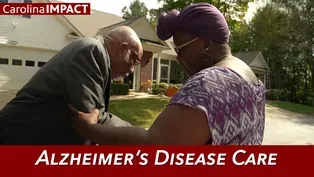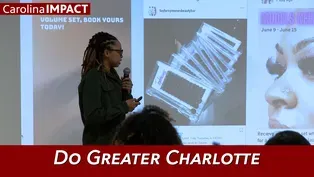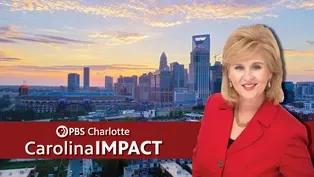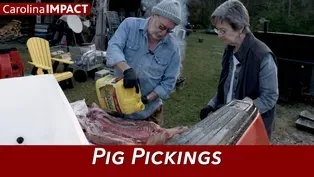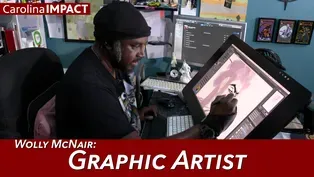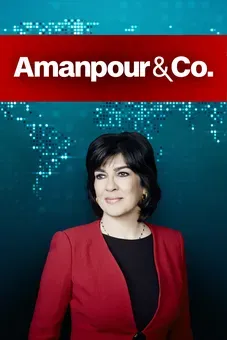
November 26, 2024 | Carolina Impact
Season 12 Episode 1208 | 27m 27sVideo has Closed Captions
Do Greater Charlotte, Alzheimer’s Disease Care, Pig Pickings, Graphic Artist Wolly McNair.
Do Greater Charlotte empowers Charlotte area kids to learn about the world of creativity, Caring for a loved one with Alzheimer’s can be tough, see how the journey can be easier, Meet Dan the Pig Man and learn about the tradition of whole hog barbecue, & Meet Wolly McNair, a graphic novel illustrator, freelance artist and mentor to young people.
Problems with Closed Captions? Closed Captioning Feedback
Problems with Closed Captions? Closed Captioning Feedback
Carolina Impact is a local public television program presented by PBS Charlotte

November 26, 2024 | Carolina Impact
Season 12 Episode 1208 | 27m 27sVideo has Closed Captions
Do Greater Charlotte empowers Charlotte area kids to learn about the world of creativity, Caring for a loved one with Alzheimer’s can be tough, see how the journey can be easier, Meet Dan the Pig Man and learn about the tradition of whole hog barbecue, & Meet Wolly McNair, a graphic novel illustrator, freelance artist and mentor to young people.
Problems with Closed Captions? Closed Captioning Feedback
How to Watch Carolina Impact
Carolina Impact is available to stream on pbs.org and the free PBS App, available on iPhone, Apple TV, Android TV, Android smartphones, Amazon Fire TV, Amazon Fire Tablet, Roku, Samsung Smart TV, and Vizio.
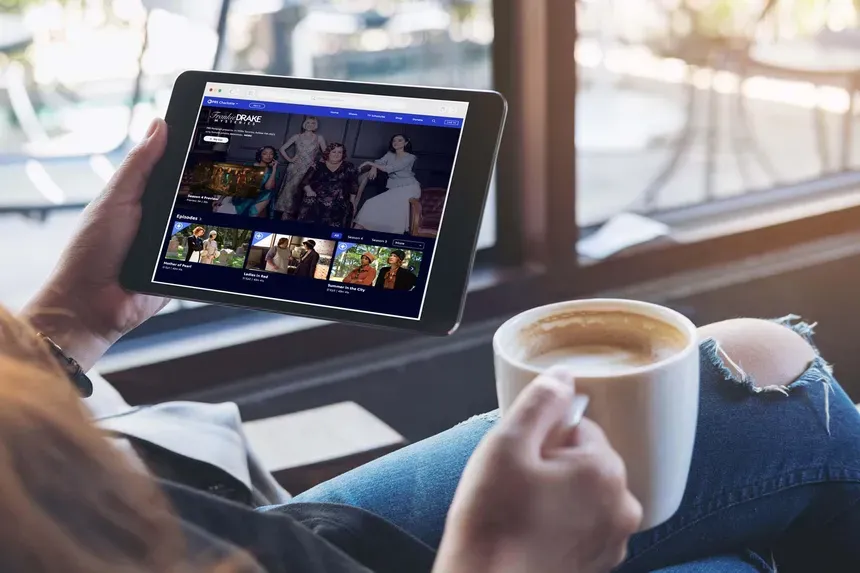
Introducing PBS Charlotte Passport
Now you can stream more of your favorite PBS shows including Masterpiece, NOVA, Nature, Great British Baking Show and many more — online and in the PBS Video app.Providing Support for PBS.org
Learn Moreabout PBS online sponsorship- [Announcer] This is a production of PBS Charlotte.
- Just ahead on "Carolina Impact," a Charlotte nonprofit uses entrepreneurship to empower kids in underserved areas.
Plus, we show you how to make caring for a loved one with Alzheimer's a little bit easier.
And how a local graphic artist gives back to the community.
These stories and more starting right now on "Carolina Impact."
(upbeat music) Good evening, thanks so much for joining us.
I'm Amy Burkett.
It came as a shock to many when it was released a decade ago, a 2014 study by Opportunity Insights ranked Charlotte dead last among the top 50 largest US cities in terms of upward mobility.
Essentially saying children born into poverty are more likely to remain there as adults if they live in Charlotte.
But a recent follow up study showed Charlotte is on the move in the right direction.
"Carolina Impact's" Jason Terzis has the details.
- Well, the good news is we're not 50th any longer.
The Queen City moving up a dozen spots on the list to now 38th overall.
The study comparing factors such as income inequality, family structure, education, race, and social capital.
Over the last decade since that dead last ranking, civic and corporate leaders in Charlotte have banded together to address some of the core issues.
Tonight, we take a look at one nonprofit organization that's been taking the issue head on.
- Okay, everybody, we're gonna go on ahead and get started.
- [Jason] It's not a school, but it does conduct classes.
From one entitled "Design to Dollars."
- And I'm here to teach you how to make stuff and sell stuff.
- [Jason] To the art and business of deejaying.
- And my goal for you guys is at the end of this, you have the ability to play an event.
- [Jason] And printing and silk screening in a class called "Startup Apparel."
- [Instructor] Once everything is taped up on the sides lined up, the pre-production is almost done.
- [Jason] These classes are taking place in, ready for this?
The basement of a church, the Shiloh Institutional Baptist Church on Charlotte's west side.
- EY studies that showed that 28208 zip code was the, you know, highest unemployment rate in the city of Charlotte, which we sit right in today.
- So we target our west side schools for recruitment, and then we also partner with other nonprofits who are already working with students that would be perfect for our programs.
- If you are making a key chain, make your canvas two inches in width and two inches in height.
- [Jason] The organization setting up the curriculum and running the classes is called Do Greater Charlotte.
- Do Greater was this actualization for me after being in corporate America for a number of years to give back to the west side of Charlotte.
- [Jason] Do Greater's mission, teach kids about the things they're interested in, but don't typically learn about in traditional school settings.
- [Instructor] All right, now do it one more time because you want to get more of that ink.
- Kids love creativity and music and video and photography and these types of things that they deal with every single day.
We thought, how could we take that creative pursuits and incorporate that in a space and start to train them around critical thinking and problem solving skillsets?
- It was like a 20-week long program for like digital creatives.
- Our programming is based on three different pillars.
So we do programming and entrepreneurship, so teaching students how to start and run their own businesses.
We do programs on digital creativity.
So a lot of those skill sets that would complement entrepreneurship.
So graphic design, photography, and then we also have innovation programming.
And so that's teaching students how to use the design thinking process to think about the big problems in the world and apply that design thinking process to come up with solutions.
- Deejaying is a perfect trade for you guys to pick up and have in your back pocket.
- [Jason] Classes are taught by industry professionals who donate their time to impart knowledge and wisdom to the students in various aspects of the creative world.
- "Design to Dollars" is a great example of that.
- Again, another example of the same design.
If you want it engraved, this is what it would look like.
And if you want it in color, that's what it would look like.
- It's teaching students entrepreneurial traits on how to price and create products, but it's also teaching them the digital design skills.
- My mom would always ask me, because my mom's an entrepreneur, and she would always ask me, she always asks me this question of, "What sets you apart from other photographers?"
And then I would always be like, "Well, it's my style of photography.
Like, it's how I do things."
And she's like, "No, it's not."
And then that would always confuse me.
But then having someone who could actually like break it down to me and then show me like the actual things, like down to from everything, from how I word like what I do to Google Analytics, right, and how my website shows up.
Like, that helped a lot.
- [Jason] Most of the kids finishing the course programs usually stick around taking advantage of the equipment and space Do Greater has to offer.
They provided it to me like the thing that was like my biggest hurdle, which is like getting the equipment and being able to use it.
- When a student comes in, they have access to all of the technology that we've outfitted the creative lab with.
So whether that be MacBooks or Procreate or Adobe software or cameras that they just wouldn't have access to in another environment.
- [Jason] Do Greater founder and CEO William McNeely is a native West Sider himself.
- My experience is mainly with technology companies.
Most of my career was spent at Apple in educational technologies.
- [Jason] In 2015, William was diagnosed with idiopathic pulmonary fibrosis, despite never having been a smoker.
In 2019, he underwent a double lung transplant.
- And so coming out of that transplant, it was like, "Boom, let's move this thing to action.
I think it's great."
It really was birthed out of my desire to, one, take advantage of the second chance that I had.
And, two, understanding how I was affected, particularly around access when I was growing up.
- [Jason] As soon as he was feeling healthy enough, William set in motion Do Greater Charlotte.
- We started 2019 with a mobile technology lab, which was a really a converted food truck, and we converted that into a technology lab filled with iPads and wireless broadband and started taking that in the community.
- [Jason] But when Covid hit, sticking 20 kids in a truck wasn't the best idea.
So they needed a space to call their own.
That's when the facility at Shiloh came about.
- And that allowed us now to try and create this hyper-local environment in a community where kids could literally just walk to and then create these, what we call creative collisions with the professionals in the community, bringing them together in a space to train and mentor kids.
- So in our two years of operating our creative lab at Shiloh, we have served over 600 students.
- [Jason] In just a few short years, Do Greater has made huge inroads in working to improve Charlotte's economic mobility challenge.
- You see the effect that we're having, you see the effect that our programs are having, particularly around these critical skills and thinking through very complex problems.
We call it creative confidence.
You see that confidence happening in our kids and so that drives us.
- [Jason] Do Greater is on the verge of taking its next step and it's a big one, renovating an old building on North Tryon Street in uptown to be its new headquarters.
Plenty of people and local dignitaries were recently on hand for a celebration event.
The new facility will have three floors of creative workspace, lounges, studios, even a coffee bar.
It will give access to even more people and allow connection with professionals in the central business district.
- Okay, Jason, what's the timeline on the new uptown location?
- Construction, well underway, and they're hoping to have it up and running by next spring.
The goal is March, but whenever it does open, it will be a huge step for Do Greater.
Also, the Shiloh location will remain open.
The long-term plan is to have locations all over town to make it as easy as possible for kids to access.
And going back to the introduction to our story where we said Charlotte had moved from 50th up to 38th on the big city list in terms of upward mobility.
Some city leaders like city manager Marcus Jones said being 50th was sort of a blessing in disguise because he's not sure if business leaders around town would've bonded together and been as aggressive as they were to initiate change.
And one other quick little side note, Atlanta now 50th on that list.
- Ooh.
Hey, it's great to make progress and appreciate you sharing that story with us.
- Absolutely.
- November is Alzheimer's Awareness Month, and we all likely know someone suffering from the disease.
Here in North Carolina, more than 210,000 people are living with the disease and over 373,000 loved ones are providing care.
"Carolina Impact's" Dara Khaalid and videographer John Branscomb give us an inside at that journey.
- [Dara] Moments like this with her family.
- I'm a creature of habit.
- [Dara] Bonding and putting together puzzles.
- I like a dark green.
- [Dara] Means so much more to Debbie Teague these days.
- I know.
- [Dara] She holds onto every bit of joy she feels in her heart because she knows there's a possibility she won't remember it in the future.
- And then I get teary because I can't figure out what I'm wanting to say and I'd get frustrated with myself.
- [Dara] The 65-year-old was diagnosed with younger onset Alzheimer's disease a little over a year ago.
It impacts her memory as well as her communication.
- He will see me and I'm not, can't figure something out.
And he said, "What are you trying to do?"
"I don't know."
And he'll say something and it pops in my head and I say, "That's it."
- [Dara] Her husband Marc of 46 years remains by her side.
He's taking on more household chores, keeping her encouraged, and coming to terms with their new reality.
- Just accepting that she, I don't know if I can get this out but that she does have Alzheimer's.
And life is not the way it used to be, you know?
It's changed, and it's scary what might lie ahead.
- [Dara] Before Debbie was diagnosed, the couple's two daughters begin to notice changes like her misplacing items, forgetting things and repeating herself.
These are all signs medical experts say people should take seriously.
- If someone has early signs of something like Alzheimer's disease or even a condition that precedes Alzheimer's disease called mild cognitive impairment, it is so important for them to be seen because we have medications that are available to slow down the progression of Alzheimer's disease.
- [Dara] According to the Alzheimer's Association, nearly 7 million Americans are dealing with the disease caused by complex brain changes after cell damage.
It affects thinking, behavior, and memory and worsens over time and can have major impacts on daily activities.
- The rates of Alzheimer's in America, even here in North Carolina, will arise mostly because of risk factors: heart health, diabetes, cholesterol, blood pressure.
- [Dara] Research shows that older African Americans are twice as likely as older whites to have Alzheimer's or other forms of dementia.
Among African Americans 70 and older, 21.3% are living with Alzheimer's.
Neurologist Robert Wiggens explains a possible cause.
- One thought is that it may be related to these modifiable risk factors.
So whether people are more likely to have things like diabetes, blood pressure issues, cholesterol.
- [Dara] Wiggins says factor can be socioeconomic status, which impacts people's access to healthy food, education, and doctor's visits.
Fortunately, 89-year-old Xxere Perry's daughter recognized something was wrong with her father seven years ago.
- So my dad started presenting with tremors, and I knew those tremors because my grandfather had tremors.
And so I kind of knew that kind of what he was dealing with even before we got the official diagnosis.
- The diagnosis turned out to be Alzheimer's related to Parkinson's disease, which is a movement disorder of the nervous system that can cause tremors.
Tanya Blanding immediately became her father's caregiver, helping him with daily tasks like preparing medications and cooking.
- I always remember what he did for me when I was young, so I try to keep that as a mindset as I'm caring for him now.
I wanna give him the same love and attention that he gave me as a young person.
- [Xxere] That my booboo.
- [Dara] And Xxere has a furry friend looking after him too.
- She's definitely a companion to my dad.
She watches out for him.
She knows what her assignment is.
If she feels that he's not feeling well, she'll come and get me and she's on her job.
- When she first came, I said, "She's going to sleep out there," because I didn't want no dog in the house.
Now, I can't do without that mutt.
- [Dara] He can't do without his daughter either.
- She's a loving person to be with, and I enjoy her very much and I love her.
- [Dara] Doctors tell us for those like Tanya taking on the tough role of caregiving, it's critical to make sure they don't neglect themselves and truly lean into their support system.
- You're on the same team, not only with the person you love, the person you're providing care for, but also your doctors, the nurses.
This can be a very difficult disease to not only treat, but also to care for.
So it's really important just to know who your teammates are.
- [Dara] And even though it's a challenging disease, there's still hope.
- The landscape previously in Alzheimer's disease was really focused on what we call symptomatic therapy or symptomatic treatment.
What that was, was mostly what I call like an oil change.
It might make someone feel a little bit better, but it really wasn't having an impact on the progression or the worsening of Alzheimer's disease.
Things now, though, are dramatically different.
We have several approved medications.
- [Dara] Two of those are lecanemab and donanemab.
These medications have proven to slow the progression of the disease.
As research continues to evolve, it gives families more time to make precious memories that patients may not remember, but those closest to them certainly will.
For "Carolina Impact," I'm Dara Khaalid.
- Thanks so much, Dara.
Experts say you can reduce stress for Alzheimer's patients by creating a consistent daily routine as you care for them.
It helps you and them know what to expect.
Well, the Carolinas are known for many things: our beaches, our mountains, and more notably our barbecue.
But have you ever wondered why?
"Carolina Impact's" Jason Terzis and producer John Branscomb introduce us to Dan the Pig Man to find out.
- [Jason] With the sun just coming up.
- [Dan] I call this a Carolina Gold Day.
- [Jason] Somewhere in York County.
- [Dan] The smell on a fall day, it hypnotizes you.
- [Jason] Lives a unique individual.
- [Dan] This guy was in the field on Wednesday, today's Friday.
- [Jason] Some call him Dan the Pig Man.
- This pig was raised in Union County, North Carolina.
- [Jason] Others know him as Dan Huntley, former writer for "The Charlotte Observer" turned barbecue pit master.
- You can get around the back.
- [Jason] With the help this morning from his partner Kay.
- Just grab him by the feet.
- [Jason] Dan's right in his element.
- To me, on a misty morning, you know, with some split oak and hickory and a pig, it's primal.
- [Jason] Primal and simplistic.
- I've done it a lot of different ways and tried to not modernize it, but kind of goose it up a little bit, and I've come full circle.
I'm back to where I started.
Salt and smoke.
- [Jason] With a tailgate doubling as a countertop, they're prepping the essential ingredient.
- He's a little over 50 pounds.
- [Jason] For a Carolina tradition centuries in the making, a Carolina pig pickin'.
- [Dan] Drop him off there.
- [Jason] And this freshly slaughtered hog will be the star of the show.
- [Dan] Just drop him.
- Just drop him?
- [Dan] Yeah, yeah.
(chuckles) - [Jason] Huntley's personal philosophy for making great barbecue.
- You don't want to get between the low smoky fire and the salt and the pork that they were doing 200 years ago.
- [Jason] Throughout the Carolinas, you'll find very distinctive styles of barbecue.
- The barbecue you typically get in Eastern Carolinas is a whole hog that's slow smoked like this.
And then you get the tenderloin, you get the ribs, you get the dark meat, you get all of that mixed together.
Barbecue in Piedmont, for the most part, are more shoulders and Boston butts, or the hams.
- [Jason] Perhaps the main difference from eastern to western North Carolina and into South Carolina, the type of sauce.
- Particularly eastern North Carolina, and to a lesser degree, the Lowcountry of South Carolina, it's more of a vinegar-based, pepper, red pepper flakes.
mm, a little bit of sugar, but not much.
As you get into the Piedmont in North Carolina, it's more of a tomato-based and sugar sauce.
You know, Lexington, down around Charlotte, and up into the mountains around Boone.
And it's a thicker, sweeter sauce with little vinegar.
- [Jason] Before the advent of supermarkets and large scale industrial agriculture, farmers in the Carolinas were mostly self-sufficient, raising much of what they would eat right on the farm, including pigs.
So when the fall rolled around and the crops were out of the fields, farmers often saw the harvest as a reason for celebration.
- You know, farmers have a gathering out around the tobacco sheds or something like that, you know, like a early Thanksgiving.
- [Jason] While it may look like an old tobacco shed, Huntley's old barn is now a cooking shed and serves much the same purpose as a gathering place for friends and family.
- I'm from Charleston, South Carolina.
We are very much into our pigs and barbecue.
I can't wait to eat and just to have the conversation, the music, and the laughter and everything that comes with that.
It's just a good time.
- [Jason] As more guests arrive.
Craig Morrow, a skilled pit master himself, lends a hand with the final details.
- Like this right now is the best part where you're cutting all the stuff and getting everything in place, and you're trying to anticipate what everyone's gonna want.
And we've got some kettle beans, we got some mac and cheese, we got some slaw, we got some good Hawaiian buns, and we got a pickle board, which I'm excited about.
I didn't even know what that was.
But I mean, I'll tell you, I know now, and I'm gonna apply it into my repertoire.
A pig pickin', everyone can kind of let their guard down and be who they actually are.
You can admit almost anything during a pig pickin'.
It's almost like a confessional, but it's a lot less pressure.
- [Jason] Much like a chuck wagon cook in the Old West, Morrow signals the hungry crowd that it's time to eat.
Or I guess you could say pig out.
(metal ringing) - Come and get it!
- [Jason] As humans, we are naturally drawn to find our own community or tribe.
- So it's a way to celebrate life and to appreciate what you have and the people that are in it.
- You gotta come to one, you gotta see one.
My words fail in response to what it actually is.
(folk music) - As the night concludes with an impromptu folk music jam, Huntley sums it all up.
- [Dan] You can't fake barbecue.
- For "Carolina Impact," I'm Jason Terzis reporting.
- Thank you so much, Jason.
While pork is still king of the barbecue in the Carolinas, more and more pitmasters are spreading their culinary wings with other items like Texas-style brisket and Kansas City ribs.
Well, growing up in Lumberton, one local artist didn't have a lot of financial resources, but with paper and ink, he was always able to unlock a world of imagination.
So much so that he became a professional graphic artist.
Getting to work with companies like Nike.
Producer Russ Hunsinger shows us how Wolly McNair now gives back to the creative community helping young people.
♪ Good times ♪ ♪ Any time you meet a payment ♪ - [Wolly] My great grandmother, she let me start watching "Good Times."
And in "Good Times," there was a character named JJ who painted.
- Voila!
- It was the first time I saw somebody Black on TV painting.
And finding out later from my grandmother and family that the painter from that show was Ernie Barnes.
And Ernie Barnes was from North Carolina.
So that blew my mind even more that there was a Black artist, Black artist from North Carolina, Black artist who was getting paid for art.
And that just opened up this world of, ooh, I want to explore this art thing.
I think exposure to greater things is important, period, but it definitely helps to see somebody who you can identify with because it makes it more realistic that it's possible.
You know, if you see something you can't identify with, if a certain part of you doesn't click with it, you may not think that's for you.
But if you see somebody you can identify with and it's like, oh, well, if they were capable of doing it, then it's still a path for me, there's a possibility for me.
So I think that's super important.
I've worked with the Mint Museum, I've worked with The McColl, the Johnson C. Smith, The Harvey Gantt Center.
I have permanent pieces over there.
And then outside of Charlotte, my work has been Atlanta, Virginia, DC.
One of the most notable would be my collaboration with Nike, which happened through Black Sheep Skate Shop, getting to work on the character design for the Black Hornet dunks.
I was living back and forth between Lumberton, North Carolina and Charlotte, North Carolina.
We were very wealthy in spirit and community, but financially we didn't have a lot.
So it was rough, it was a lot of things happening.
Kindness and people caring has been major throughout the steps of my life.
And I wouldn't be here without some of the people who spoke up and said, "Hey, bro, this ain't necessarily the path," or some of the people that were willing to take the time to just have conversations.
And so trying to make sure that I'm present and aware and as much of that as I can be authentically to other people is important to me.
(uplifting music) - They are mesmerized when he comes into the classroom.
He has a way to just captivate them.
So Grier Heights Youth Arts program is for ages 4th grade to 12th grade.
I think the main mission statement is to help through art.
Art is a catalyst for change.
And through that mindset to be able to transform their lives, that they have a better quality of life, that they can make better decisions, that they have more self-confidence and self-esteem, and that they can be a more engaged citizen.
We engage with a lot of creative artists in the city.
The way the program is designed, artists are invited in to do modules.
So, for instance, we work with an artist Wolly, and Wolly is an artist, he's an entrepreneur, he's an illustrator, he's a published author, and he is in the community.
And so Wolly is one of our favorites because he has this very mellow, laid back way about him, and he never seems to be stressed.
And so when he comes in, he brings that aura with him.
And his component of teaching is about being a superhero.
And that superhero is the student.
- Ms. Rubie's like, we like to call her the art mom.
She's a very important person in the art community here.
She's always been very supportive of the arts and of the youth having access to art, and the community having a voice and trying to be a voice herself, but also open the door to others that can speak in a different way.
- [Rubie] When Wolly talks to the students, he brings in his own life story.
And he lets them know, "I'm not telling you about something I think or I've read or I've seen on a movie screen.
I'm telling you about my actual life.
And I grew up in a very challenging community."
And so his way out was to come to Charlotte.
His way out was to draw, to create.
He's so creative.
- Grier Heights and other places like where I grew up, we didn't have a lot of these type programs, and so to have something like that available where kids can come for free and spend time getting to meet people that they might not have crossed paths with otherwise was super important.
That's been a heavy part, man, of just trying to make sure we are the example and we are setting the standard, and then they take that and elevate it.
- And so we're working with the children to help them to understand that art can take them anywhere they want to go.
- So if I can inspire anybody in a positive way, that then becomes the vessel to inspire somebody else, that then inspires two more people, then I've accomplished something great in my lifetime.
You know what I'm saying?
- He has so much talent.
Thanks so much, Russ.
So what's next for Wolly?
Over the next year, he has three new graphic novels coming out.
As for the arts program, it's celebrating its 20th anniversary of helping young people reach their potential.
Over that time, they've served nearly 500 students.
We hope you enjoyed learning about our neighbors who are making a community an amazing place to live.
We'd love to hear about your incredible neighbors too.
Please email us your ideas to stories@wtvi.org.
Before we leave you tonight, I wanna thank the amazing students from the Imeck Academy of Global Influencers who were fantastic spending time in our audience.
They had great questions and they were super quiet.
Well, that's all the time we have this evening.
Thanks so much for your time.
We always appreciate it, and we look forward to seeing you back here again next time on "Carolina Impact."
Good night, my friends.
(upbeat music) - [Announcer] This is a production of PBS Charlotte.
(gentle music)
Video has Closed Captions
Caring for a loved one with Alzheimer’s can be tough, see how the journey can be easier. (5m 57s)
Video has Closed Captions
Do Greater Charlotte empowers Charlotte area kids to learn about the world of creativity. (6m 17s)
November 26th, 2024 Preview | Carolina Impact
Do Greater Charlotte, Alzheimer’s Disease Care, Pig Pickings, & Wolly McNair Graphic Artist (30s)
Video has Closed Captions
Meet Dan the Pig Man and learn about the tradition of whole hog barbecue. (5m 2s)
Video has Closed Captions
Meet Wolly McNair, a graphic novel illustrator, freelance artist and mentor to young people (5m 3s)
Providing Support for PBS.org
Learn Moreabout PBS online sponsorshipCarolina Impact is a local public television program presented by PBS Charlotte
